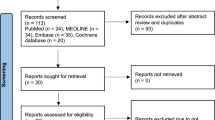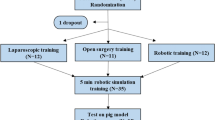Abstract
Conventional laparoscopic surgery (LS) is being challenged by the ever-increasing use of robotic surgery (RS) to perform reconstructive procedures. The purpose of this study was to assess the acquisition of skills in both techniques and the potential transfer of skills from one technique to the other when restricted spaces are involved. A preclinical randomized crossover study design was implemented. Twelve subjects performed two different reproducible drill procedures: “Thread the Ring” (TR) and “Transfer the Plot” (TP). To assess surgical proficiency in confined workspaces, these exercises were performed with LS and RS technology in a pediatric laparoscopic surgery (PLS) simulator. Each performance was recorded and evaluated by two reviewers using objective structured assessment of technical skills (OSATS). The times to complete the TP and the TR procedure were significantly shorter with RS compared to LS (64 s vs. 319 s; p < 0.0001 for both TP and TR). A significant transfer effect of skills between LS and RS was noted for the TP exercise (p = 0.006). The percentage improvement was greater overall with LS, meaning a higher number of trials were required to adequately master the procedure. This study demonstrated that RS performed significantly better compared to LS on pediatric simulation devices. A transfer effect was identified from LS to RS exclusively. The learning curves showed that progression was definitely longer with LS. These results, indicate that novice surgeons should be encouraged to persist with learning LS, and they support the use of a pediatric robotic simulation device.



Similar content being viewed by others
Abbreviations
- RS:
-
Robotic surgery
- LS:
-
Laparoscopic surgery
- PLS:
-
Pediatric laparoscopic surgery
References
Szold A, Bergamaschi R, Broeders I, Dankelman J, Forgione A, Langø T et al (2015) European association of endoscopic surgeons (EAES) consensus statement on the use of robotics in general surgery. Surg Endosc 29:253–288
Pugin F, Bucher P, Morel P (2011) History of robotic surgery from AESOP® and ZEUS® to da Vinci®. J Visc Surg 5(148):e3–e8
Barbash GI, Glied SA (2010) New technology and health care costs—the case of robot-assisted surgery. N Engl J Med 363:701–704
Andolfi C, Kumar R, Boysen WR, Gundeti MS (2019) Current status of robotic surgery in pediatric urology. J Laparoendosc Adv Surg Tech A 29:159–166
Erkul E, Duvvuri U, Mehta D, Aydil U (2017) Transoral robotic surgery for the pediatric head and neck surgeries. Eur Arch Oto-Rhino-Laryngol 274:1747–1750
Scirè G, Mariotto A, Peretti M, Buzzi E, Zani B, Camoglio F et al (2014) Laparoscopic versus open appendectomy in the management of acute appendicitis in children: a multicenter retrospective study. Minerva Pediatr 66:281–285
Boysen WR, Gundeti MS (2017) Robot-assisted laparoscopic pyeloplasty in the pediatric population: a review of technique, outcomes, complications, and special considerations in infants. Pediatr Surg Int 33:925–935
Bălănescu RN, Bălănescu L, Drăgan G, Moga A, Caragaţă R (2015) Biliary lithiasis with choledocolithiasis in children. Chir Buchar Rom 110:559–561
Azzie G, Gerstle JT, Nasr A, Lasko D, Green J, Henao O et al (2011) Development and validation of a pediatric laparoscopic surgery simulator. J Pediatr Surg 46:897–903
Seixas-Mikelus SA, Kesavadas T, Srimathveeravalli G, Chandrasekhar R, Wilding GE, Guru KA (2010) Face validation of a novel robotic surgical simulator. Urology 76:357–360
Davila DG, Helm MC, Frelich MJ, Gould JC, Goldblatt MI (2018) Robotic skills can be aided by laparoscopic training. Surg Endosc 32:2683–2688
Panait L, Shetty S, Shewokis PA, Sanchez JA (2014) Do laparoscopic skills transfer to robotic surgery? J Surg Res 187:53–58
Hassan SO, Dudhia J, Syed LH, Patel K, Farshidpour M, Cunningham SC et al (2015) Conventional laparoscopic vs robotic training: which is better for naive users? A randomized prospective crossover study. J Surg Educ. 72:592–599
Faulkner H, Regehr G, Martin J, Reznick R (1996) Validation of an objective structured assessment of technical skill for surgical residents. Acad Med J Assoc Am Med Coll 71:1363–1365
Anderberg M, Larsson J, Kockum CC, Arnbjörnsson E (2010) Robotics versus laparoscopy-an experimental study of the transfer effect in maiden users. Ann Surg Innov Res 4:3
Thomaier L, Orlando M, Abernethy M, Paka C, Chen CCG (2017) Laparoscopic and robotic skills are transferable in a simulation setting: a randomized controlled trial. Surg Endosc 31:3279–3285
Trudeau MO, Carrillo B, Nasr A, Gerstle JT, Azzie G (2017) Educational role for an advanced suturing task in the pediatric laparoscopic surgery simulator. J Laparoendosc Adv Surg Tech A 27:441–446
Meier M, Horton K, John H (2016) Da Vinci© skills simulatorTM: is an early selection of talented console surgeons possible? J Robot Surg 10:289–296
Ballouhey Q, Clermidi P, Cros J, Grosos C, Rosa-Arsène C, Bahans C et al (2018) Comparison of 8 and 5 mm robotic instruments in small cavities: 5 or 8 mm robotic instruments for small cavities? Surg Endosc 32:1027–1034
Trinh BB, Hauch AT, Buell JF, Kandil E (2014) Robot-assisted versus standard laparoscopic colorectal surgery. JSLS. https://doi.org/10.4293/JSLS.2014.00154
Shim JI, Jo E-H, Kim M, Kim MK, Kim M-L, Yun BS et al (2019) A comparison of surgical outcomes between robot and laparoscopy-assisted adenomyomectomy. Medicine 98:e15466
Esposito C, Masieri L, Blanc T, Manzoni G, Silay S, Escolino M (2019) Robot-assisted laparoscopic pyeloplasty (RALP) in children with horseshoe kidneys: results of a multicentric study. World J Urol. https://doi.org/10.1007/s00345-019-02632-x
Autorino R, Eden C, El-Ghoneimi A, Guazzoni G, Buffi N, Peters CA et al (2014) Robot-assisted and laparoscopic repair of ureteropelvic junction obstruction: a systematic review and meta-analysis. Eur Urol 65:430–452
Gettman MT, Peschel R, Neururer R, Bartsch G (2002) A comparison of laparoscopic pyeloplasty performed with the da Vinci robotic system versus standard laparoscopic techniques: initial clinical results. Eur Urol 42:453
Mazzon G, Sridhar A, Busuttil G, Thompson J, Nathan S, Briggs T et al (2017) Learning curves for robotic surgery: a review of the recent literature. Curr Urol Rep 23(18):89
Chandra V, Nehra D, Parent R, Woo R, Reyes R, Hernandez-Boussard T et al (2010) A comparison of laparoscopic and robotic assisted suturing performance by experts and novices. Surgery 147:830–839
Acknowledgements
The authors thank R. Peymirat for his technical assistance with image editing.
Author information
Authors and Affiliations
Corresponding author
Ethics declarations
Conflict of interest
The authors declare that they have no conflicts of interest or financial ties to disclose.
Additional information
Publisher's Note
Springer Nature remains neutral with regard to jurisdictional claims in published maps and institutional affiliations.
Appendix 1
Appendix 1
“The following instructions for the TP exercise were provided to all of the students: a series of six plots are transferred one by one; a ring on the left side of the pegboard is grasped with the instrument in the left hand, lifted off the peg, transferred to the grasper in the right hand, and then placed onto a peg on the right side of the pegboard. After all the rings are transferred left to right, the process is reversed [9].
The second exercise, TR, consists of successively channeling a suture needle through three 1 cm diameter vertical rings with one hand and recovering the thread with the other one.
Each exercise has to be executed five times per operator and per technique: standard laparoscopy and robotic platform.”
Rights and permissions
About this article
Cite this article
Moncayo, S., Compagnon, R., Caire, F. et al. Transition effects from laparocscopic to robotic surgery skills in small cavities. J Robotic Surg 14, 525–530 (2020). https://doi.org/10.1007/s11701-019-01024-y
Received:
Accepted:
Published:
Issue Date:
DOI: https://doi.org/10.1007/s11701-019-01024-y




